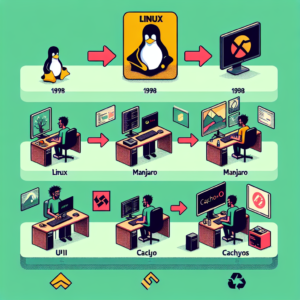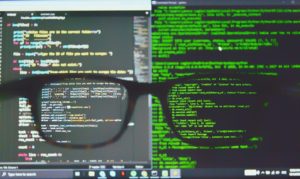# Introduction to Open Source Operating Systems: A Historical Overview
The concept of open source software, where the source code is freely available for anyone to view, modify, and distribute, has revolutionized the software development landscape. The origins of open source operating systems trace back to the early days of UNIX in the 1970s, a foundational system developed by AT&T’s Bell Labs. UNIX’s design principles and modularity allowed for variations to spawn, leading to the development of numerous UNIX-like systems.
In the 1980s, the GNU Project, initiated by Richard Stallman, aimed to create a completely free UNIX-like operating system. Although the project developed many of the necessary tools, it lacked its own kernel until the emergence of Linux, created by Linus Torvalds in 1991. Linux, combined with GNU tools, formed a fully functional free operating system, which has since become the poster child for open source projects.
The proliferation of the Internet in the 1990s provided the perfect environment for open source software to flourish, allowing developers from around the world to collaborate. The establishment of organizations like the Open Source Initiative in 1998 helped formalize the definitions and defend the ethos of open source software, promoting an environment of development transparency and community-oriented progress.
# The Evolution of Linux: From Creation to Current Status
Linux began as a personal project by Linus Torvalds to create a free operating system kernel. Its initial release was modest and intended primarily for hobbyists. However, the simplicity, robustness, and the GPL (General Public License) under which it was released, encouraged a rapidly growing community of developers to improve and expand upon the original source code.
Over the years, Linux has grown from a simple kernel to an entire ecosystem encompassing numerous distributions (distros) like Ubuntu, Fedora, and Debian. Each distro offers different configurations and user experiences, tailored for various user needs ranging from personal computing to professional enterprise environments.
The kernel itself has evolved significantly, driven by contributions from around the world. Notably, major corporations like IBM, Google, and even Microsoft, have contributed to its development, recognizing Linux’s importance in server environments, embedded systems, and even as part of Windows’ subsystem for Linux.
Linux’s adaptability has allowed it to power a wide range of hardware from supercomputers to smartphones (via Android), making it the most versatile operating system in the world. As of now, Linux systems power much of the internet’s infrastructure, a majority of the world’s stock exchanges, and the ten fastest supercomputers globally.
# Key Features and Benefits of Linux Compared to Proprietary Systems
One of the most significant advantages of Linux over proprietary operating systems like Windows or macOS is its open-source nature. This allows users and developers to customize the OS down to the kernel level to suit their specific needs. Such flexibility has made Linux particularly popular in academic and scientific communities, where specialized applications are common.
Linux’s robustness and security are also noteworthy. Its permission and user role features provide an inherent security advantage over many proprietary systems, where security vulnerabilities are often exploited more widely. Moreover, the transparency of open source code allows for quicker identification and patching of security flaws.
Cost-effectiveness is another critical benefit. Linux and many of its distributions are free to use, which is particularly appealing for startups and developers with limited budgets. In contrast, proprietary systems often come with high licensing costs.
Performance and efficiency in Linux are typically superior, especially in server environments. Linux servers are known for their stability and reliability, often boasting high uptimes without the need for frequent reboots.

Why did I start to use Linux? -And why should you also try it?
# The Role of Linux in Modern Computing Environments
In modern computing, Linux’s role is multifaceted. In enterprise environments, Linux is favored for its stability, security, and cost-effectiveness. It dominates the server market, running on the majority of the world’s public cloud infrastructure. Linux-based Android is also the most popular smartphone operating system globally, showcasing Linux’s versatility.
In the realm of cloud computing, Linux’s open-source model offers an ideal platform for developing cloud-native applications, thanks to technologies like Docker and Kubernetes, which were born and matured in Linux environments. This has made Linux an integral part of the DevOps movement, facilitating continuous integration and continuous delivery (CI/CD) practices.
Linux is also pivotal in the areas of big data and artificial intelligence. Most big data platforms like Hadoop and Spark are developed and run optimally on Linux systems. The open-source nature of Linux allows researchers and developers to modify the system to handle large datasets efficiently.
# Emerging Trends in Open Source Software Development
The open source model has proven highly successful, and current trends suggest it will continue to influence software development significantly. One major trend is the increased involvement of large corporations in open source projects. Companies like Microsoft, traditionally known for proprietary software, are now among the biggest contributors to open source repositories like GitHub.
Another trend is the rise of open source software in government and education sectors, where transparency, cost-effectiveness, and security are paramount. Governments worldwide are adopting open source solutions for digital public goods, recognizing the benefits of shared, collaborative software development to enhance public services.
The growth of open source software has also spurred the development of supportive services like open source security and management solutions, which help organizations adopt open source software while ensuring it is secure and well-maintained.
# Challenges Facing Linux and Open Source Platforms Today
Despite its successes, the open source model, including Linux, faces several challenges. One of the primary concerns is security. While open source allows anyone to inspect and improve the code, it also exposes it to malicious users. Ensuring timely patches and managing vulnerabilities require constant vigilance and community coordination.
Another challenge is the sustainability of open source projects. Many projects struggle with funding, as the model does not inherently generate revenue. Burnout and turnover among voluntary contributors can stifle projects, which sometimes leads to poorly maintained or abandoned projects.
There is also the challenge of fragmentation; the open source world is replete with projects that often duplicate efforts, splitting the community and resources. This can slow down the development progress and confuse users about the best tools for their needs.
# The Future of Operating Systems: Linux vs. Proprietary Rivals
Looking ahead, the competition between Linux and proprietary systems is likely to intensify, with each pushing the other toward innovation. Linux’s flexibility and robustness will continue to make it an attractive option for emerging technologies. However, proprietary systems are not standing still; they are incorporating more open source components and adopting more flexible licensing models.
The increasing importance of privacy and data security might give Linux an edge, as its open-source nature allows for more transparent and controllable systems. On the other hand, proprietary systems often have more resources for comprehensive marketing and user support, which can be appealing to less tech-savvy users.
The integration of AI and machine learning into operating systems could be a significant battleground for Linux and its rivals. Both camps are actively developing smarter, more autonomous systems that could redefine what operating systems can do.
# Conclusion: What Lies Ahead for Open Source and Proprietary Systems
The future of operating systems is likely to be shaped by their ability to adapt to new technologies and user needs. For Linux and other open source platforms, the challenge will be to maintain the spirit of open collaboration while ensuring sustainability and security. For proprietary systems, the challenge will be to innovate while offering compelling reasons for users to choose their products over free alternatives.
Ultimately, the competition between open source and proprietary systems benefits all users, leading to more robust, secure, and innovative computing environments. As technology continues to evolve, the principles of openness and collaboration that underpin the open source movement will likely become even more influential, guiding the development of new technologies and systems.



